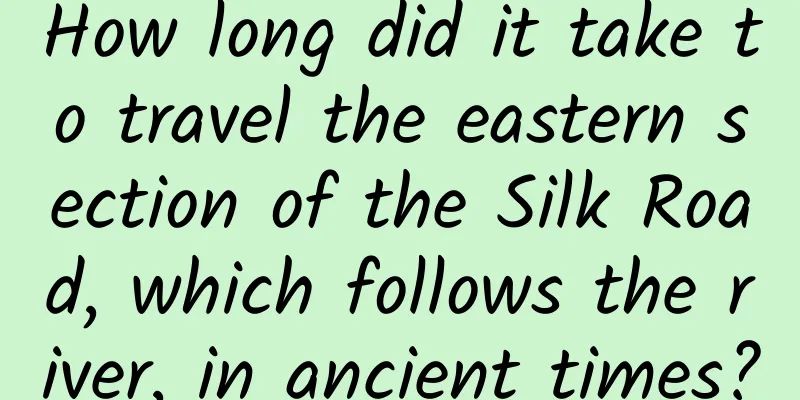How long did it take to travel the eastern section of the Silk Road, which follows the river, in ancient times?

|
How long did it take for ancient people to travel the eastern section of the Silk Road, from Chang'an to Dunhuang, if they chose different routes, used different means of transportation, faced different social environments, and undertook different diplomatic missions? By examining the Han Dynasty bamboo slips, documentary records, and the itinerary diaries of the parties involved, we can come to a preliminary understanding: the beacon fires and military emergency reports of the Han Dynasty could be reported from Dunhuang to Chang'an in eight days through the express horses of the post stations along the way; under normal circumstances, it took more than one month to two months for officials to travel from Chang'an to Dunhuang using the vehicles provided by the post stations along the way. Moreover, from the Han and Tang Dynasties to the Ming and Qing Dynasties, before the invention of motor vehicles, it has been consistent for more than two thousand years, with almost no fundamental changes. Of course, there are also cases of more than 20 days, which are the result of traveling day and night due to the urgency of the situation; the civilian merchant groups walking on the Silk Road, because they are encouraged by the government and hold the government's seal, are also received by the post stations along the way. The walking speed from Chang'an to Dunhuang can be roughly referred to the situation of the officials on the envoys; the monks who go to the West to seek Dharma have different situations. They have to walk all the way, preach the Dharma and make friends all the way. It is normal for them to go back and forth for several years or even decades. As we all know, it took Zhang Qian 12 years to reach the Western Regions, from his departure in 138 BC to his return in 126 BC. However, he was not on the road for more than 10 years. Instead, he was detained by the Xiongnu when traveling to and from Jiuquan, and spent most of his time with the Xiongnu. Then, Zhang Qian made his second mission to the Western Regions. Huo Qubing set up four counties and occupied two passes in the Hexi expedition, Li Guangli set up an expedition to Dayuan (104-101 BC), the Han Dynasty sent envoys and lieutenants to cultivate Quli, and established the Western Regions Protectorate (60 BC), etc., which made the road between the Central Plains and the Western Regions smooth. In this case, how long does it take to get from Chang'an to Dunhuang? According to the records of Han Dynasty bamboo slips, here are a few different examples: In the fifth year of Yongguang (39 BC), an official named Li Zhong lost an important official document. In order to prevent lawless people from obtaining this document to engage in illegal activities, the court issued a notice to the whole country to offer a reward, requiring those who obtained this official document to hand it over to the government as soon as possible, otherwise they would be severely punished. This notice was issued on June Yi Hai (July 23) and arrived in Dunhuang on July Geng Shen (September 6), which took 46 days. For another example, in the fifth year of Yongguang (39 BC), an envoy of the King of Kangju came to the Han Dynasty to pay tribute and establish friendly relations. As a result, after arriving in Jiuquan, there was a dispute with local officials over some specific details of assessing tribute and reception. As a result, the Kangju envoy reported the matter to the court, and the court sent officials in charge of diplomatic affairs to Jiuquan and Dunhuang to investigate along the way. The official set out from Chang'an on June Gui You (July 21) of that year and arrived in Dunhuang on July Geng Shen (September 6), which took 47 days on the way. According to the itinerary requirements at that time, "a hundred li a day" is equivalent to about 41 kilometers today. From Chang'an to Dunhuang, about 1,800 kilometers, more than 4,300 Hanli, generally takes more than 40 days. The speed of the above two examples is basically consistent with this. Of course, there were also cases where it was faster than this. For example, in the fourth year of Ganlu (50 BC), the court sent a doctor named Ma Cang to Dunhuang to supervise the digging of the canal. He set out from Chang'an on the 16th day of the sixth month (August 16) and arrived at Xuanquanzhi on the 7th day of the seventh month (September 7). He walked for 23 days, which was quite fast. He walked nearly 80 kilometers a day. At that time, the court had something to do with Wusun (the capital of Wusun was in Chigu City, near Lake Issyk-Kul in Kyrgyzstan today), and was preparing to send troops to attack Wusun. Digging canals and controlling water was a top military priority at the time, so it might be necessary to speed up. In addition, in the third year of Jianping (3 BC), the court sent a man named Zhong to Dunhuang to serve as the commander of Yumen. He set out from Chang'an on the 21st day of the fifth month (June 21) and arrived at Xuanquanzhi in Dunhuang on the 25th day of the sixth month (July 25), a total of 34 days. The Yumen Duwei was a border military officer who had to take up his post and perform his duties without delay, so he started 10 days earlier than normal. During the Han Dynasty, the route from Chang'an to Dunhuang was mainly along today's National Highway 312 from Xi'an to Pingliang, then northwest along the east side of Liupan Mountain, entering Jingtai and going straight to Wuwei, without passing through today's Lanzhou. When the court officials traveled, they used the post stations along the way and took the post station's carriages to travel from one station to another. There were as many as nine post stations like Xuanquanzhi in Dunhuang County, each 30 kilometers apart. In addition to a certain number of post horses for delivering official documents and letters, the post stations must also have a certain number of carriages for messengers and guests to ride. For example, Xuanquanzhi had a quota of 36 horses, 10-15 carriages, and about 40 staff. The carriages were divided into carriages driven by one or two horses and carriages driven by four horses according to their status. The officials in the above example traveled from Chang'an to Dunhuang in carriages provided by post station reception agencies such as Xuanquanzhi. During the Eastern Jin Dynasty, there was a monk named Faxian. He went to India to seek Buddhist scriptures in 399, and did not return to Qingdao by sea until 412. When Faxian traveled west, the Sixteen Kingdoms in the north were in conflict. He set out in 399, passing through Chang'an and Qifu Qiangui's Western Qin (the capital was Jincheng, now Lanzhou), and then spent the summer there. He then went to Tufa Southern Liang (the capital had been moved from Ledu to Xining), and passed through Biandukou to enter Zhangye. At that time, the Houliang regime in Zhangye had been replaced by Duan Ye. After spending the summer in Zhangye, Faxian went to Dunhuang, which was controlled by Li Hong's Western Liang regime. He successively experienced four separatist regimes: Western Qin, Southern Liang, Northern Liang, and Western Liang. It took two years to travel from Chang'an to Dunhuang alone. More than a hundred years later, Song Yun, a native of Dunhuang, was sent to India by Empress Dowager Hu of the Northern Wei Dynasty to seek 170 Mahayana Buddhist scriptures. The route to the west was roughly from Luoyang, the capital of the Northern Wei Dynasty, through Shaanxi and Gansu, crossing the river from Hezhou, through the Qaidam Basin, passing Ruoqiang, along the northern foot of the Kunlun Mountains, crossing the Pamirs and the Hindu Kush Mountains, through present-day Afghanistan to Peshawar, Pakistan. From the end of the first year of Shengui (518) to the third year of Zhengguang (522), it took more than four years to go back and forth. The great Tang monk Xuanzang set out from Chang'an in August of the first year of Zhenguan (627) to seek Buddhist scriptures. After more than four months of trekking, he arrived in Gaochang at the beginning of the second year of Zhenguan. According to the record of "Biography of Tripitaka Master of Da Ci'en Temple", his itinerary was as follows: "At that time, there was a monk named Xiaoda from Qinzhou who was studying the "Nirvana Sutra" in Beijing. After completing his study, he returned home, so he went with him. When he arrived in Qinzhou, he stayed for one night and met his companion from Lanzhou, so he went to Lanzhou with him. After one night, he met people from Liangzhou who were sending official horses back, so he went there with them. He stayed for more than a month. At that time, the national politics was still new, and the border was not far away, so the people were not allowed to go out. At that time, Li Daliang was the governor of Liangzhou. Since he had received the strict imperial edict, he was particularly strict in preventing and prohibiting. There was Master Huiwei, the leader of Hexi, who was intelligent and wise. He respected the master's words and reasoning, and when he heard about his aspiration to seek the Dharma, he was deeply delighted, and secretly sent two disciples, one named Huilin and the other named Daozhen, to secretly send him west. From then on, he did not dare to go out publicly, but hid during the day and traveled at night, and finally arrived in Guazhou." According to later research, Xuanzang stayed in Liangzhou for more than a month and in Guazhou for more than a month. "From the capital, we traveled 3,300 miles northwest to Guazhou." If we traveled 100 miles a day, it would take at least 30 days. From Guazhou to Yiwu (Hami), the road was extremely difficult and dangerous. "I could only see bones and horse manure. I looked around and saw no people or birds. At night, demons lit fires that were as bright as stars. During the day, the wind blew sand and scattered it like rain." I didn't see water for four days and five nights. In the third year of Tianfu (938) of the Later Jin Dynasty, Li Shengtian, the King of Khotan, sent people to Kaifeng, the capital of the Later Jin Dynasty, to pay tribute. Shi Jingtang sent his subordinates Zhang Kuangye and Gao Juhui to Khotan to confer the title of Dabao King of Khotan on the King. From the third year of Tianfu to the seventh year of Tianfu (938-942), it took four years to go back and forth. It mainly started from Lingzhou (Yinchuan area), passed through the Tengger Desert to Minqin, and then passed through Liangzhou, Ganzhou, Suzhou, and Shazhou to enter Khotan. Along the way, they passed through the Dangxiang, Tubo, Cao's Guiyi Army, and some separatist regimes west of Dunhuang. The passage was blocked by checkpoints along the way. Yelu Chucai followed Genghis Khan in his expedition to the Western Regions, which lasted six years from 1218 to 1224, and he reached Khwarezm (now Uzbekistan) in Central Asia. Changchun Zhenren Qiu Chuji was summoned by Genghis Khan to travel west in 1219, and it took him three years to meet Genghis Khan in his tent in northern Afghanistan in 1221. However, these two traveled west from today's Inner Mongolia through the Altai Mountains, and did not take the Hexi Corridor. Chen Cheng in the early Ming Dynasty made several diplomatic missions to the Western Regions. The second time he went to the capital of the Timurid Empire, Khalid (now Herat, Afghanistan), he wrote the "Journey to the Western Regions" and "Records of the Western Regions". At that time, Chen Cheng's delegation departed from Beijing in the 11th year of Yongle (1413) and arrived in Jiuquan in the first month of the 12th year of Yongle (1414), which took more than three months. The "Journey to the Western Regions" records that they set out from Suzhouwei, the Xingdusi of Shaanxi Province, on the 13th day of the first month of the 12th year of Yongle (February 3, 1414) and headed west. They passed through Yili, Xinjiang, and then through Samarkand in Central Asia, and arrived at their destination on the first day of the ninth month of the leap year (October 14). It took a total of 254 days to travel from Jiuquan to Herat, Afghanistan. The entire journey of this mission, from departing from Beijing in September of the 11th year of Yongle to returning to Beijing in October of the 13th year of Yongle, took two years to go back and forth. During the Qing Dynasty, transportation to the Western Regions, especially after Xinjiang was established as a province, became normalized and a typical journey from Xi'an to Dunhuang took about two months. |
Recommend
SMIC Financial Report: Revenue in 2024 Reaches a New High of 58.68 Billion Yuan, Capacity Utilization Rate of 85.6%
According to recent news, SMIC announced its unau...
The mini program is launched amazingly, but why do I think it is bad?
In the early morning of January 9, the WeChat min...
World Osteoporosis Day | This free method is better than calcium supplementation
October 20th is World Osteoporosis Day, and this ...
Marketing promotion: innovative ways to achieve big marketing with a small budget!
Can’t you do marketing without money? By masterin...
How to use WeChat mini-programs to retain customers? What should I do if I quit using WeChat Mini Program?
Q: How to use WeChat Mini Program to retain custo...
The Internet Integration Model and Influence of American Television Media
When the Internet and other emerging media are su...
CES2015: Can't wait, Apple accessory manufacturers have already displayed new products
Before the opening of CES 2015, Griffin, a well-k...
Is there any scientific basis for the saying “diseases come from the mouth”?
"Diseases come from the mouth" is somet...
As a product grows from 0 to 100, what is operations doing?
When I was in college, I started to get involved ...
Three WeChat functions are easy to be targeted by scammers. You need to quickly check and remove them. The elderly also need to know
When we use WeChat, there are actually 3 function...
How does Weibo content marketing build IP?
Whether now or in the future, the value and influ...
A cartographic miracle! A 430-year-old hand-drawn giant world map opens your journey through time
Leviathan's note: The world map by Urbano Mon...
The Miracle Behind Sleep: What Does Your Body Do When You Fall Asleep?
We spend a precious time every night, that is, sl...
Baise Moving Mini Program investment price inquiry, how much is the Baise Moving Mini Program investment price?
What is the investment cost of Baise Moving Mini ...
"Nuclear" war continues, game consoles will give rise to a hardware watershed for Android devices
The introduction of game consoles into China has ...









